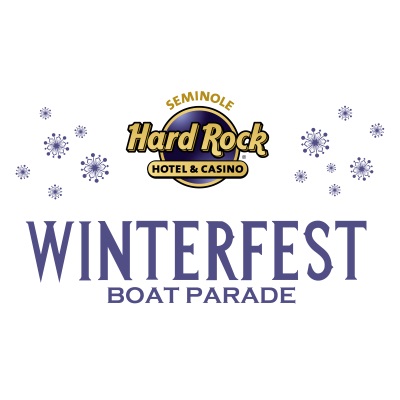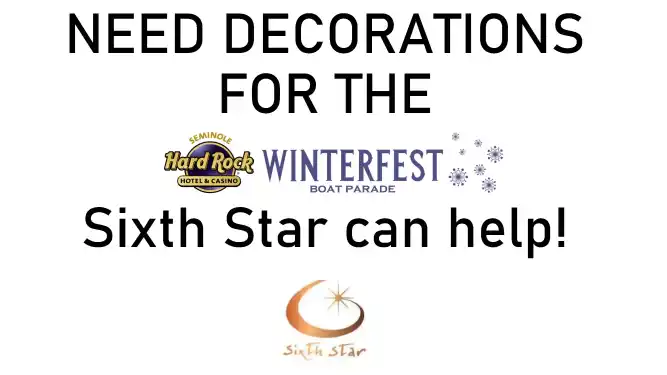THE BASICS
- THEME: The 2025 Parade Theme is “Yacht Rock of Ages”
- Get your friends and family together to discuss theme ideas and remember the music, props, and skits – everyone is a star in the Parade
- DECORATIONS: Both sides of the boat must be decorated the same.
- DESIGNS: Use a pattern / coroplast / foam board / bead board /corrugated plastic sheets/styrofoam, etc. for fun and creative designs. Draw designs on coroplast, then paint or outline in rope lighting.
- DO NOT USE SPRAY PAINT on foam–it will dissolve. Acrylic or vinyl paint is best. If you work with a sign company, they can help create your designs. (HELPFUL HINT: You can use a projector for outlining characters or images on boards!)
- Punch holes to place lights or staple rope lighting. You will have to figure out the placement of the lights with a 50 or 100 ct. light string. Space them so you have enough to go around the figure(s) as desired. You can always tie up the extra in the back, just make sure you are not short. Use a screw driver to punch holes in the foam.
- TEST THE LIGHTS FOR VISIBILITY AT NIGHT PRIOR TO PARADE!
- ATTACH DECORATIONS TO THE BOAT: Use plastic tie wraps for the figures and lights.
- ATTACH FIGURES AND LIGHTS TO THE BOAT: Tie the corners and anywhere else it matches a rail to secure it. Be careful – remember wind can move objects – use the plastic tie wraps in all corners of the foam board.
- Please remember costumes, fabrics and spotlights to enhance your decorations!
- FRINGE: one of the best ways to decorate your hull!
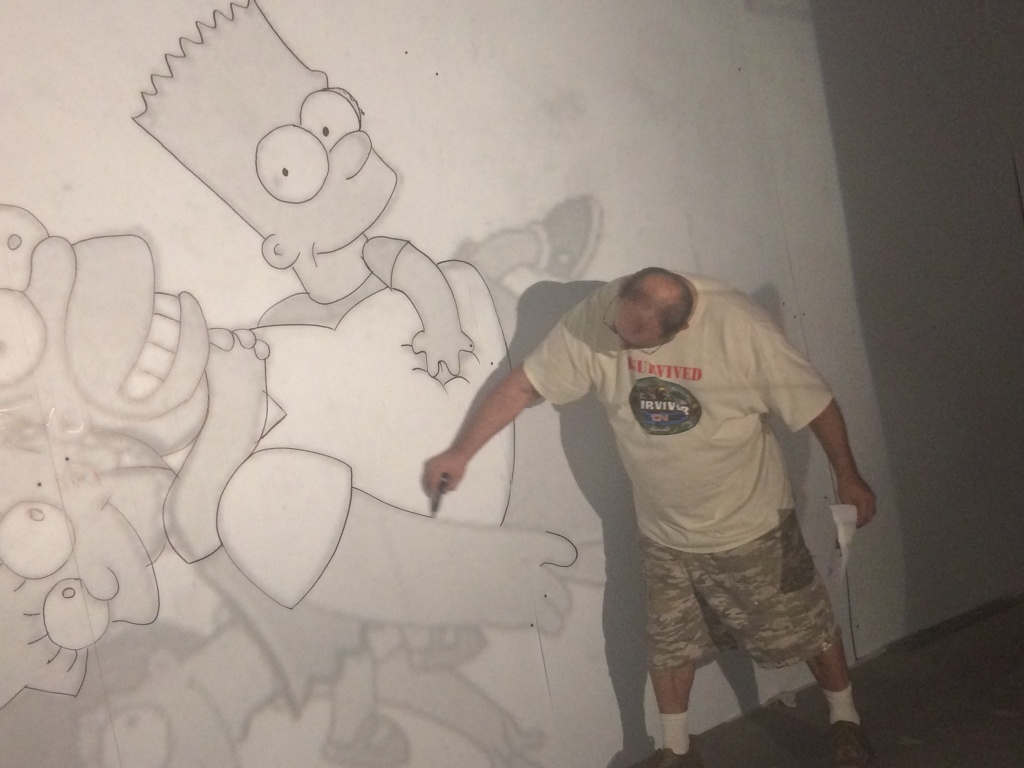
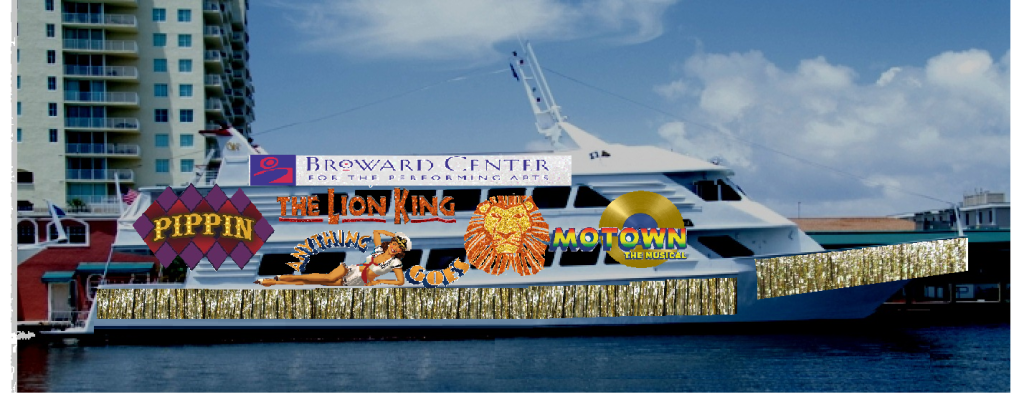
DECORATING TIPS AND TRICKS from THE PROFESSIONALS:
Get a catalog of decorations for rent!
Winterfest’s own decorating playlist can be found on YouTube. Click the video below to watch our video…
Please remember costumes, fabrics and spotlights to enhance your decorations! And Don’t forget your hull – use glittery mylar curtains.
Katie Walters, DECO Productions, Inc.:
“Make your designs are as large as can fit your boat so that it can be seen clearly from the shore.”
Doug Jones, from Sixth Star Entertainment, Inc., wants to ensure that you:
- Measure your boat to determine where your signage, lights, and props will fit.
- Note that props and signs that are not lit will not be seen.
- Use LED lights whenever possible.
- Make sure to overdo it if you are planning on overdoing it with lights.
- Identify your “hang points” on the sides of boats
- Make Signs
- Can use twinkle lights or C7 lights then pop them thru corrugated plastic (See Pictures) It is a quick, easy and cost-effective way to create signage
- Trace or print letters or images onto corrugated plastic and then outline them with rope light (See Pictures)
- Understand that it is best to use a drill and small zip ties
- Know that corrugated plastic is available at Home Depot and in larger quantities locally from E&T Plastics https://shop.e-tplastics.com/landing/florida-lauderdale-branch.aspx
- Know that mylar floral sheeting can be used to enhance… it is available online from several different vendors
- Party City, Shindigz, and Wal-Mart also offer this online
- For added support, you can use PVC piping or wood to enhance the stability of your signs.
- Attach your wires and extension cords to the railing… never lying on the deck
- Use sandwich bags to protect plugs and connections
- Always have the opening of the plastic bag down and zip tied closed
- Understand that a good sound system and handpicked music is a detail that makes a big difference!
- Always include Costumes and Props… make sure to light the area!
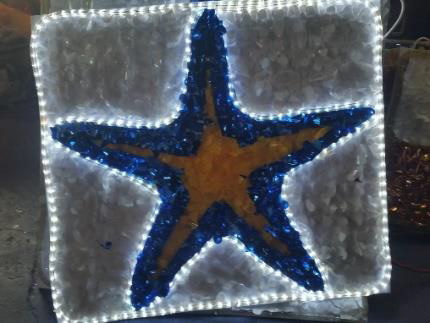
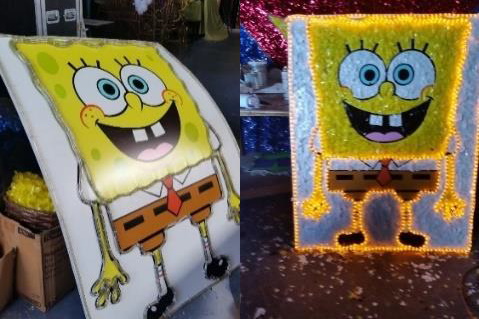
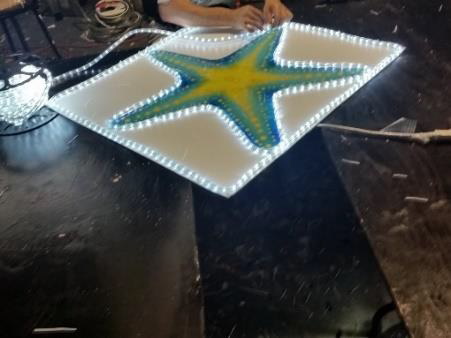
TIPS from AWARD WINNING WINTERFEST BOATERS
Rob Kornahrens:
Have a checklist. A sample list for the parade would include:
- Meet with friends and family to discuss theme ideas – make sure music can be incorporated into your theme.
- Plan your design with your boat in mind. A sailboat and a powerboat need two different designs.
- List your materials: Rope lighting, coroplast, and zip ties
- Schedule your time
Britt Lanier:
“I feel the most important and the hardest part is in the planning. Each year, depending on the theme of the Parade, we come up with a concept. Usually, a vision ‘pops’ in my head quickly, but I find it really develops when it’s laid out on paper. Sometimes, this may only be a quick sketch. This past year, we were working with a new boat, so I worked with the help of a few JPEGS and a PowerPoint. Once the concept is laid out, it’s just a matter of finding materials and hundreds of ‘Zip Ties’. Then we gather a group of family, friends, and employees, put in a few days of work and concentrate on having a lot of fun.”
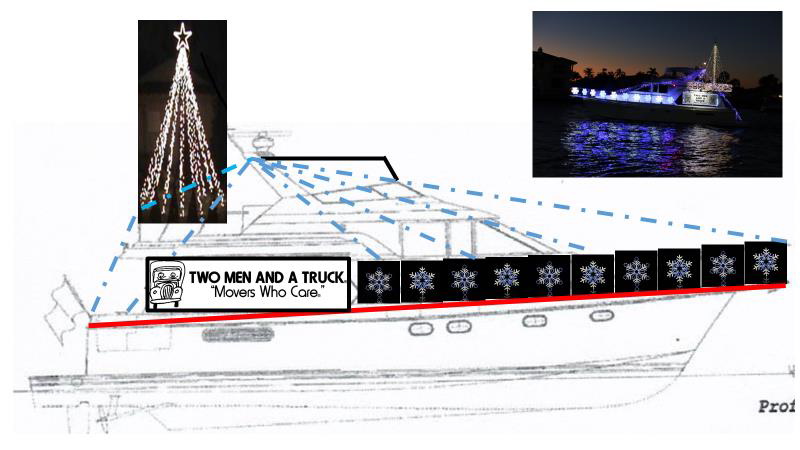
Scott McIlvaine
Scott McIlvaine:
- The first thing starts with a Winterfest theme. Take that idea and build from it to come up with your own theme within the theme.
- Get ideas from your family and friends, google for more ideas, but make sure that whatever you come up with you have the resources to pull it off.
- Keep in mind that the lighting, sound and any decorations need to be clearly visible from 100 feet away at night. They need to be able to withstand possible rain and high winds.
- Safety should be the main concern as you develop your ideas and your decorations. Envision yourself at the helm, navigating at night with possible rain and wind. You must have clear visibility and maneuverability during the course of the parade.
- Plan early and allow yourself several weeks to get all that together so that you’re not rushing at the last minute. This process takes time to do it right, start early and you’ll be very pleased with the outcome.
IN DEPTH
Additional decorating tips from a story on Boat US website:
Look at your boat and build on its strengths,” says Pete Chambliss, Chief Elf (yes, really) of the Eastport Yacht Club Lights Parade in Annapolis, Maryland. While displays can be as simple as a strand of lights run along the toe rails, or as elaborate as Santa and the Abominable Snowman cage fighting on the bow while the elves look on, each one starts with a design. A powerboat is longer than it is tall, so it supports horizontal designs well. A sailboat works better with designs with some height.
Decide how you want onlookers to view the display. Inflatables on the foredeck can be viewed equally well from all sides of the boat, while words written in lights may be seen best from the port or starboard side. Now is the time to figure out what decorations to use, how to power them, and how to attach them securely to the boat. Outdoor-rated LED lights approved by Underwriters Laboratory (UL) last a long time, use little energy and produce less heat, avoiding fire hazards. Many yard decorations can do double duty on a boat, too, because their size makes them easy to see and they’re already graded for outdoor use.
Keeping Your Decorations Safe When Powering Up
Adding extra lights to a boat increases the risk of fire and electrical shock, so deciding how to power the display has important safety implications. Before hanging them on the boat, check the lights for frayed wires and loose bulb-base connections. Wrap plug connections tightly between strands with high-quality electrical tape, and don’t overload circuits. The number of strands that can be connected together depends on the type of lights, size of the wiring in the set, and power source being used on the boat.
AC-powered lights can be plugged into an inverter running off a boat battery; you’ll want to use LEDs to minimize the current draw. You can also power up using a properly installed marine genset (be sure to fuel up during the day), but don’t use a portable generator. Not only is there a risk of carbon monoxide poisoning with a portable, they could tip over if you get hit by a wake and the hot exhaust could cause burns or start fires. If using AC power, use an amp meter to balance your circuit load, and make sure to use a pigtail with a ground-fault circuit interrupter (GFCI) as close to the source as possible. This will shut the power down if anything goes wrong in the circuit. AA battery-operated lights and 12-volt lights plugged into a 12-volt outlet are other options. If 12-volt outlets are used, the wiring and outlets must be protected by fuses or breakers properly sized to protect the wires supplying power to the outlet from carrying more current than they can safely handle. Any wiring connections should be clean and free from corrosion.
To check the ABYC allowable ampacity of conductors, download the rating table from Blue Sea Systems or check a reference guide such as Boatowner’s Mechanical and Electrical Manual by Nigel Calder. Look at the specs of the lights you want to use, and consult the manufacturer’s instructions or an electrician. Test all the decorations and their power source on land during the day. It’s easier to replace faulty bulbs, correct overloaded circuits, and add more lights to a sparse display before you hang them on the boat. To further minimize the risk of fire or neon Rudolph going up with a bang, have no flames aboard, keep the bilge clean, and have fire extinguishers and flashlights operational and easily accessible. It’s a great idea for each crewmember to have a small safety light or beacon attached to their clothing, should they need it. Just make sure your crew knows not to use lights in a manner that will interfere with the vision of others. Have safety personnel/spotters with a whistle to notify the captain if an issue arises.
Getting It All Up There
Attaching decorations when you don’t have walls to tack things to is tricky. A simple method involves attaching lights with wire ties or duct tape. To make words or pictures from lights, use chicken wire. String the lights to the wire, and then staple it to wooden frames, easily mounted using properly-sized electrical conduit clamps, which are then secured to the boat using halyards, lines, blocks, and integral boat structures such as outriggers, masts, booms, and spinnaker poles.
String lights above the deck level, inside boat lifelines, in case docking or assistance is needed. Keep connections between strands close to the deck for easy access but high enough that seawater from waves or wake can’t reach them. Make sure to keep connections away from metal rigging and metal support structures.
Be careful not to obscure your navigation lights. Don’t decorate so bright lights fall within the skipper’s line of sight, as that will destroy his or her night vision, and designate someone to stay out of the glare who can keep watch for obstructions and help navigate (see “How To Protect Your Night Vision“).
Don’t Let Your Boat (Or Crew) Get Tied Up In Knots
Decorators should also consider how displays affect the boat’s performance and overall stability, especially because the extra weight of the structure can upset the balance of the boat. Hoisting a large chicken-wire frame is like hoisting a sail that can’t be reefed or released. If the weather is too windy, or the frame too big, it can dangerously destabilize the boat. Keep in mind the crew will still need to get to dock lines and cleats at the slip. Remember, the crew will have to be able to move about and perform jobs, some perhaps on an emergency basis. Don’t decorate in a way that interferes with safe boat operation. Double check the weather forecast before leaving the dock so that you can ensure that your boat and your decorations will weather the elements well. Prepare for the worst; if possible, have a line standing by at the cleat to prevent the crew from running around.
Float Your Art in Winterfest
For over 1 million people in South Florida, the Seminole Hard Rock Winterfest Boat Parade is the kickoff to the holiday season. In place of those first snowflakes up north, Winterfest is especially magical for both local and visitors to this area. It affords them the opportunity to celebrate the holidays in a memorable and unparalleled way that is also quintessentially Greater Fort Lauderdale.
“There is nothing more spectacular than to see a child’s eyes shine with the beauty of the Parade,” says Lisa Scott-Founds, President & CEO of Winterfest, Inc. “This is such a wonderful community event during the holiday season which reaches millions more on television and the internet.” Her tip to boaters in the Parade: “The Parade touches the hearts of so many each year, children especially, so it is important to have fun with your designs and make sure your decorations have maximum impact.”
Note: From the sidelines, actor characters need good lighting on their faces and bodies to be seen and should wear simple and bright costumes rather than costumes with small details. Remember that they are 200 feet – 500 feet tall.
Lighting Guidelines
How to Set Up Your Lights
Tip: Punch holes for placing lights or staple rope lighting. You will have to figure out the placement of the lights… a 50 light string or 100 light string. Space them so you have enough to go around the figure as desired. You can always tie up the extra in the back… just make sure you are not short. You can use a screw driver to punch holes in the foam.
- TEST THE LIGHTS AND HOW VISIBLE THE LIGHTS ARE AT NIGHT
The more lights, the better your boat will be visually! Remember, this is a nighttime parade and people on the shore need to see you. Unfortunately, we do not have a formula for LED lighting.
IF YOU ARE USING C-7, C-9 LIGHTS – this is the minimum guideline:
- Depending upon the display and type of lighting being used, a chart has been formulated to provide minimum guidelines.
- These figures are traditional Christmas tree string lights and are listed per deck (i.e. a two-deck, 40’ vessel will be required to have a minimum of 12,000 miniature lights or 3,000 C-7 & C-9 lights).
- Please remember, these are MINIMUM guidelines and Winterfest reserves the right to disqualify any entry if these guidelines are not met!
| Boat Size in Feet | Miniature Lights | C-7 & C-9 Lights |
|---|---|---|
| 20-29 | 5,000 | 1,000 |
| 30-39 | 6,500 | 1,500 |
| 40-49 | 8,000 | 2,000 |
| 50-59 | 9,500 | 4,000 |
| 60-69 | 12,000 | 6,000 |
| 70 Plus | 17,000 | 8,000 |
Check the ABYC Allowable Ampacity of Conductors
To check the ABYC allowable ampacity of conductors, download the rating table from Blue Sea Systems or check a reference guide such as Boatowner’s Mechanical and Electrical Manual by Nigel Calder.
So, how much electricity do Christmas lights use?
Your display size and choice of bulbs, whether incandescent or LED, will influence your energy bill the most. For example, a 100-count string of incandescent mini lights runs at 40 watts, while a 70 count of 5mm Wide Angle LEDs is approximately 4.8 watts total. In fact, because incandescent wattage is 80-90% more than LED wattage, the cost to power an incandescent can be up to 90x greater than powering an LED.According to EnergyStar.gov, the average price of electricity is 11.3 cents per kilowatt hour. For the power calculations below, we will use this figure per EnergyStar.gov, but you may choose to pull out your electric bill to use your actual price.
How to Calculate Electricity Usage Cost
- Know your wattage: Find how many total watts you will be using.
- Multiply times 0.001 to find kilo-watt hour.
- Multiply by 5 hours a day to find kwh/day.
- Multiply by 30 days to find kwh/season.
- Multiply by 11.3 cents, or your cost of power usage found on your electric bill, to calculate the cost.
Typical Light Usage Cost
For a complete and exhaustive guide to Christmas Lights Power Consumption vist https://www.christmaslightsetc.com/pages/how-much-power.htm
Audio Specifications

Provided by Sound & Lighting Solutions
More Power, Captain
Using a Generator
Hint: You can power almost any amount of lights and decorations, depending on the size of the generator.
- Disadvantages: While using a generator gives you the advantage of being able to use a greater number of lights and decorations, it does have some drawbacks. Some generators can be loud and can restrict your ability to hear and the limited availability of generators to rent or borrow can be a challenge if your boat isn’t already equipped with one.
Using an Inverter
You may be able to use an inverter if you have an inboard engine. Inverters invert the power from your engine’s DC current to AC. If you have an outboard engine without electric start, an inverter probably will not regenerate the on-board batteries. Inverters can be purchased at local marine suppliers. Make sure to purchase the correct inverter for your vessel. Add up the amount of watts that you intend to power and obtain an inverter with extra wattage.
- Advantages: An inverter is simple to use and uses the power your engine is already generating. It is quieter than a generator and boat engine running at the same time. When not using the inverter for decorating your vessel, you can use some of your 110-volt items from home providing you have purchased the correct size inverter.
- Disadvantages: Inverters range in price depending on how many watts you want to generate. The more watts you require, the more money you will have to spend. If you have an underrated inverter, you may find you’re without lights in 20 – 30 minutes because the safety feature of the inverter will shut it down.
Where to Get Your Generator
You can find a basic generator at your nearest home store. Below is a basic generator example:
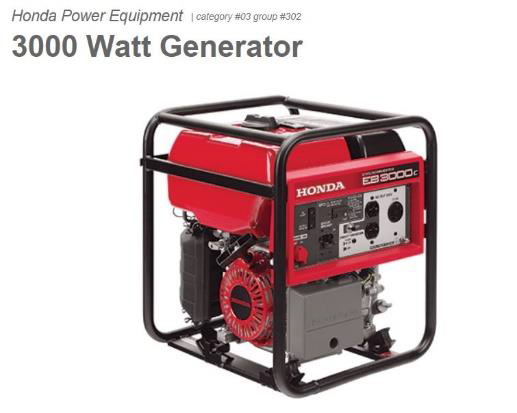
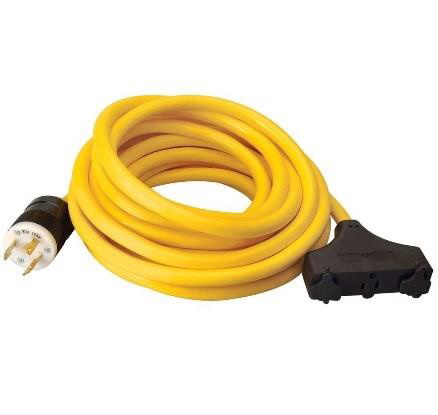
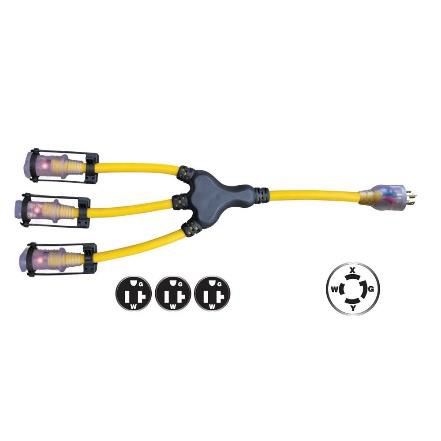
Remember, balance your load. Knowing the outlet breakers will make things simpler. Fill the gas tank before you start the parade- do it cold as a splash of gas on hot generators makes for a nice sun burn. Test run the system for one hour and feel the plugs and wires. If you feel heat, change to a heavier gauge wire.
Links
To Check Ampacity of Conductors:
http://assets.bluesea.com/files/resources/reference/21731.pdf
To Calculate Power Usage & Find Rope Lighting Discounts:
http://www.christmaslightsetc.com/
Additional Decorating Videos
Winterfest Boat Parade 2009 – Behind the Scenes – Assembling this Spooktacular Spectacle
Winterfest 2012 Boat Preparations
Winterfest Habitat for Humanity Showboat 2012
Decorating of the Patriot National Insurance Group’s Entry
Hiring A Professional Decorator
WINTERFEST ALSO has PROFESSIONAL DECORATORS that can help you create that “WOW” entry for the parade – below are some images of the parade entry and the rendering the client received to approve.
Professional Decorators
- Brandano Displays
- Deco Productions
- Designs by Sean
- Event Services Group
- Fabulous Inflatables
- Light FX Pros
- Light Up The Night
- MAD 4 Arts
- Shine
- Sixth Star Entertainment, Inc.
Contact Dawn in the Winterfest office for available decorators.


